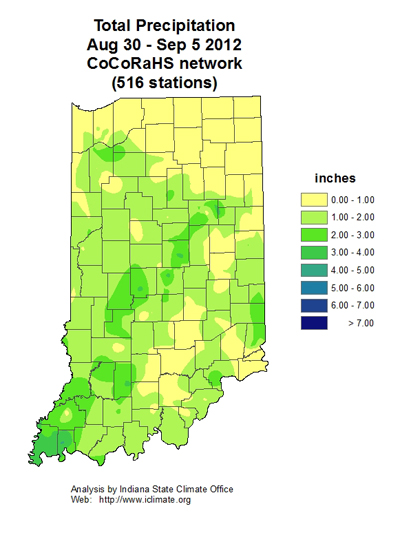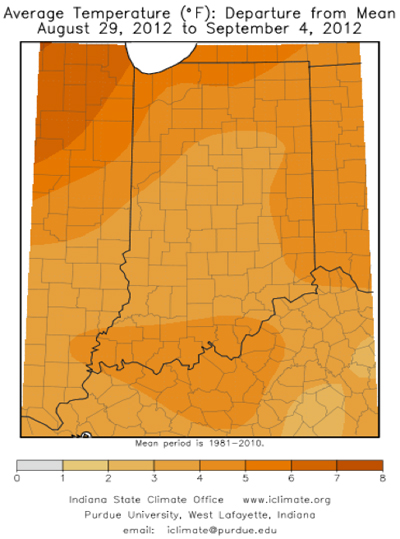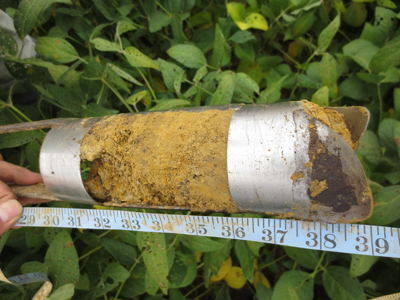Pest & Crop Newsletter, Entomology Extension, Purdue University
Click here for the Blacklight Trap Catch Report
Green Weeds In Mature Crops – (Travis Legleiter and Bill Johnson) -
The combination of an early spring-planted crops, and drought, has lead to the earlier than normal maturity of corn and soybean crops. This along with some recent rains over the last month has lead to fields that contain green, actively growing weeds, from escapes or new emergence, in fields of mature crops. Most of the time, late summer droughts, or a killing frost will dry down weed escapes prior to harvest. This year we will not have the luxury of waiting for a frost and many will need the assistance of herbicides to dry down weeds and allow for a timely harvest before crops begin to lodge.
Only a few products are available for use prior to harvest to aid in drying down green weeds. Harvest aid applications are to be made to mature crops only, not as an aid in desiccation of immature crops. Many soybean fields are maturing unevenly and will make harvest aid applications and harvest in general a challenge this fall. Producers should also keep in mind that the majority of harvest aid products are contact herbicides and that selection of spray volumes and nozzles is crucial in acquiring adequate coverage. Most labels recommend at least 10 gallons per acre for ground applications and a minimum of 5 GPA for aerial applications. Choose nozzles that allow for smaller droplets that will penetrate the canopy and cover vegetation, but also large enough to avoid drift issues.
The following table outlines the products labeled as harvest aids in corn and soybeans. As always refer to the herbicide label for further details of proper herbicide application prior to use.
Click here for the table on products labeled as harvest aids in corn and soybeans.
Smut: An Unusual Amount of a Common Disease – (Kiersten Wise) -
Farmers scouting fields for Aspergillus ear rot are observing a high incidence of corn smut. Smut is usually detected in fields every year, but poor pollination in 2012 may have contributed to the increased frequency of galls this year.
Smut is caused by the fungus Ustilago maydis, which overwinters in crop residue and soil for several years. The fungus infects leaf tissue primarily through wounds, and infects kernels on ears through silks. Tassels and nodes may also be infected. Once tissue is infected, the fungus causes plant cells to divide and expand, which results in the diagnostic white “galls” that we see with smut (Figure 1). Kernels are most susceptible prior to pollination. Mature galls are filled with dark spores that may break open and leave a powdery residue on surrounding tissue.
Figure 1. White galls produced by the fungus that causes corn smut. (Photo courtesy G. Shaner)
Researchers have debated about what conditions favor smut development, but poor pollination, dry weather, and warm temperatures have been shown to increase smut incidence, which certainly describes the growing conditions experienced in 2012.
Although smut may seem like it will impact yield, many affected ears were in fields with poor pollination and lowered yield potential due to heat and drought stress. In most years, smut is rarely yield limiting. Management options include tillage and crop rotation to reduce the amount of debris that harbors the fungus. Proper fertilization and limiting wounding by mechanical equipment will also reduce incidence of the disease. Seed and foliar fungicides will not have efficacy against this disease.
The fungus that causes smut is not known to produce toxins and will not be toxic to most humans and livestock. However, the 2012 harvest will be a dusty event due to the amount of mold spores in fields, and so those with mold allergies, respiratory ailments, or other health problems should use masks rated for molds and mycotoxins when harvesting and handling dusty grain. For more information on handling moldy grain, please see the “Managing Moldy Grain” website: <http://www3.ag.purdue.edu/extension/cornmold/Pages/default.aspx>
![]()
The Impact of Hurricane Issac on Soybean Rust in Indiana – (Kiersten Wise) -
Soybean rust has developed slowly in 2012, and as of September 5th has only been confirmed as far north as southern Arkansas and Northern Mississippi and Alabama. The hot, dry summer limited the development and spread of this disease. However, the recent storm track and resulting rainfall patterns of Hurricane Issac have increased the likelihood that spores of the fungus that causes soybean rust will move northward.
What does this mean for Indiana? Overall, the chance that soybean rust will cause economic yield loss in 2012 remains low. This is due to the following reasons:
1. The disease is currently at low levels in southern states and the amount of spores available to transport north is somewhat limited.
2. Spore transport models generated by the ZedX model at Penn State University indicate that spore transport risk is low to moderate over most of Indiana, with only the most southwestern tip of the state seeing a moderate risk of transport.
3. The time between spore deposition and disease detection is 2 to 3 weeks, but significant disease development would not occur until 4 to 6 weeks after deposition. This means that disease, if present, will not likely build up to damaging levels before most fields are harvested or near harvest.
Although we may find soybean rust in Indiana in 2012, the likelihood that we will need to manage the disease to prevent yield loss is very low.
Soybean rust development can be tracked using the ipmPIPE web site <http://www.sbrusa.net>. Updated commentary on the risk of soybean rust will be discussed in the Pest&Crop newsletter as the season continues.
Ice Age and Drought-Stricken Soybeans - (Shaun N. Casteel and Darrell Schulze) -
Does frozen water – snow, sleet, freezing rain, or ice – make a difference in our growing season? Certainly. We talk about recharging our soils during the winter months with frozen precipitation. It is no question that we want our subsoil to be recharged and the top soil layers near field capacity come spring. Soil moisture in the top layers assists in stand establishment and the subsoil moisture supplies the needs throughout the growing season.
Second question, do you think that frozen water from thousands of years ago impacted soybean growth in the 2012 drought? The soil savvy person would be quick to say yes, of course, the glacier plowed through many areas of the Midwest, including Indiana, to form the areas that we now farm. Many of the nutrient-rich soils of Indiana are relatively flat, but the small depressions that tend to hold more water will be better in 2012. The extreme dryness of 2012 has revealed additional connections to the Ice Age of long ago.
We typically see soybean growth differences within a field due to the inherent properties of the soil – drainage ability, fertility status, water holding capacity, topography, and others. In 2012, many soybean fields are demonstrating unusual patterns of growth in a field that do not match past patterns. Veins of taller soybeans wander through fields with apparently no set pattern (Figure 1). These veins of taller plants are typically 2 to 6 feet wide and the length various from a short run of 5 feet to a meandering throughout the whole field. Some fields have demonstrated differences in growth to tile patterns, but these veins of soybeans are not that systematic. In fact, the connections of soybean growth resemble a rambling stream. Aboveground growth of soybean during June was minimal, but more noticeable growth differences showed up in July.
Figure 1. Veins of taller soybeans across one field - July 27, 2012
I scouted several fields in late July and the plant height differences were 10 to 16 inches between the veins of taller plants and the areas of shorter plants. Now tall soybeans are not needed for good yields, but tall plants in these fields did indicate greater access to soil moisture. It is no mystery that soybeans that have water (especially in a droughty year) will yield more than those that do not have the water. In one field, I found that the veins of taller soybeans were 37 inches tall with 14 trifoliate nodes compared to 27 inches tall with 12 trifoliate nodes (Figure 2). The pod development and retention was also greater in the taller plants (370 pods vs. 280 pods per 1/10,000th acre) with a yield estimate of 51 bushels compared to 39 bushels. Unfortunately, more of the field was occupied with the moisture-deprived soybeans.
Figure 2. Height difference of 10 inches between veins of taller plants and the neighboring areas of short plants - July 27, 2012
I attributed these differences in plant growth due to difference below our feet and namely soil moisture, but I could not figure out what caused these patterns across the fields. I asked our resident soil scientists to provide some insight. The underlying cause was ice wedges that formed thousands of years ago. You might ask, “what is an ice wedge?” Don’t worry, I asked the same thing. The following website provides nice photos of ice wedges in arctic soils today, including an animation on how they formed <http://arctic.fws.gov/permpics.htm>. The concept holds true for our Midwestern soil landscape, which started forming at the end of the last Ice Age about 15,000 years ago. In places, huge polygonal patterns of ice wedges formed in the landscape. When the climate eventually warmed, the ice wedges melted and fine textured material filled in the space once occupied by ice. The former ice wedges now have slightly deeper soils than provide a deeper rooting depth for soybeans (and corn) than other areas of the field.Soybean maturation differences have been showing up in the last week or so. These veins of taller plants (again, access to soil moisture) continue to fill seeds and stay green, while the areas in between are starting to mature and drop their leaves (Figure 3). We scouted one of these fields on the last day of August. We bored holes down to 5 feet in these veins and between the veins of taller plants. In this one field, we saw noticeable differences in the soil texture near the 3-foot depth. The soil in the areas of shorter plants became difficult to penetrate with an auger at about 33 inches, indicating the depth to dense, compact glacial till and the maximum depth to which roots typically penetrate. Within the veins of taller plants, the soil could be augered easily down to 60 inches, was silty to much deeper depths, and still had adequate soil moisture (Figure 4). The soybean roots were able to penetrate these wedges easily in addition to having access to additional soil moisture. And now, you know the rest of the story.
Figure 3. Vein of soybeans that are still green and filling seeds, while neighboring areas are maturing and dropping leaves - August 31, 2012
Figure 4. Soil boring in the vein of taller plants where the soil is more silty and soil moisture is greater








